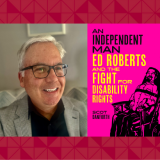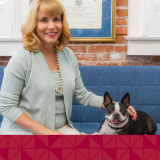
An Alternative Path Research and Publishing
February 1, 2019
At Chapman University, one of the unique aspects of the IES (Integrated Educational Studies) program is its philosophy that education happens both inside and outside of the classroom. Chapman’s educational program emphasizes the fact that the term “educator” is broad and applies to many different professions—not just teachers and professors. In addition to teaching, many of our IES faculty in the Attallah College of Educational Studies are actively engaged in research and/or publishing in peer-reviewed journals.
This month we interviewed two Attallah College professors to learn about their research work: Dr. Noah Golden, who is currently working on a field-based research project, and Anne Steketee, who recently published work in a peer-reviewed journal.
Dr. Noah Golden
Assistant Professor of Integrated Educational Studies

Dr. Noah Golden
Do you have any current projects or research you are working on?
I am working in a high school in Orange County that is often referred to as a “second chance” high school. (I can’t share the name of the school or site because it is all anonymous under research guidelines.) I am doing research on the kinds of identity work that adolescent scholars—which is what I call the high school students—do as they work to be seen as bright, powerful individuals with a range of options in their futures. As we discuss in my IES 102 (Social Construction of Difference) course, schools can sometimes reproduce social positions. There can be a sense that if someone comes from a working-class family, we are going to track them into a working-class job.
There is a lot of research, going back to the 1970s, looking at the ways that US schools can reproduce one’s class position. Of course that can happen on meso- and micro-level ways in many different facets of schooling. You could have different tracks in the same school, or even different tracks in the same classroom, that don’t really open up opportunity to everyone. So, my research is looking at the ways that teachers in school systems can interrupt those positionings to create opportunities for every student and to honor every student’s potential and the strength, cultural funds of knowledge, and resources that every student brings to the classroom.
I collaborate with a teacher. I spend time in the classroom. I interview teachers, students, and administrators to learn more about how this successful program is working. Then I share this research with the broader education community. The program started last year, and I travel to the school once or twice a week and spend time with the students and the teacher, and I interview people.
I have a graduate student in our doctoral program who is helping me analyze the data that I get. I also have articles and manuscripts that I worked on that are in the process of publication. I presented that work at two national conferences in the Fall of 2018. Fortunately, I will have the added opportunity of presenting two papers at a conference in April 2019 as well.
Anne Steketee, M.Ed.
Adjunct Professor and Ph.D. Candidate of Attallah College of Educational Studies

Anne Steketee
Are you currently working on any writing projects or research?
I am actually involved in several writing projects that are at different points in the publication process.
First, I am working on rewriting an article that has been accepted for publication that focuses on the topic of weaponizing ableism. Essentially, this article explores how children with disabilities were used prior to the onset of the Holocaust. I chose this topic because of an experience I had when I was taking a PhD-level class on the history of disability rights. I was concerned by a lack of representation of voices of color, international voices, etc. The class was amazing, but I kept looking for intersectional issues and representation at complex levels. Selecting the deaths of disabled children, and the institutionalized consequences that followed, enabled me to satisfy both the goals of the class and my own personal goals to step into issues that deal with more intersectionality. Examining the Holocaust through the lens of ableism moves both our understanding about the Holocaust and our conception of disability in a meaningful direction for society. This has implications for contemporary social policy.
After I completed the paper, my professor suggested I submit it for publication. When I wrote it initially, it had reflected my attempt to be authentic in class. But now, I am committed to the message of the paper; I feel like there is an important, albeit uncomfortable, conversation that can be initiated in this area.
Second, through my collaboration with Dr. Trisha Sugita [Attallah College Assistant Professor and Special Education Program Coordinator], I have had another article accepted for publication that is currently in revision as well. The article centers on Dr. Sugita’s research, which examines teachers who have been trained with a disability studies mindset who then enter into general education spaces and attempt to apply that same mindset.
Lastly, I recently finished submitting to Dr. Sugita a very long article about a multistate study, looking at the disproportionality of autism statistics for preschool through 12th grade. We are polishing that up to submit for publication soon.
Could you describe the writing process? What are the steps one needs to take to become published in a peer-reviewed journal?
Usually, the first step is to identify a topic you are interested in. It could be something from scratch or a piece of writing you are currently working on, as long as you identify a specific topic.
The next step is to identify a suitable journal that might work for your piece. This is a huge step that, I think, is sometimes overlooked. It is essential to select a specific journal at the beginning of the process because each journal has different requirements, a different audience, and even a different feel. If you write your article before considering the guidelines, you run the risk of having to make major revisions in order to satisfy the target journal’s specifications. Requirements can differ from word counts to writing standards—all of which can impact the writing process greatly.
After you have written your piece and identified a journal, it is beneficial to select several exemplar articles. This is key to the writing process because it allows you the opportunity to start a conversation and participate in an intellectual dialogue with authors who have been published in the target journal. Seeing as they have accomplished what you are working toward, it adds an extra element to your writing if you are able to respectfully enter into their arena of ideas by first acknowledging their work within your own. These exemplar pieces are also critical in determining the quality of writing that is expected, and you can use these articles as a standard to which you can compare your own article.
The final step is to get the submission ready, which is a very arduous and time-consuming process. Depending on the journal requirements, there are multiple “hoops” you must jump through in order to be able to submit your article— for example, you might need an ORCID (Open Researcher and Contributor ID) number. It is important to note that during the submission process you are only allowed to submit your article to one journal at a time. Because you cannot submit your piece to multiple journals at once, you can expect to wait a long period of time before hearing back from any journals. Unless they reject you very quickly! Based on prior experience, at this step I typically identify multiple journals in one list so that if my article is not accepted to one journal, I already have another journal that I would like to submit to.
What advice do you have for students interested in publishing work in the future?
The best piece of advice that I can give is to just try. The publication process can seem daunting, but there is no harm in just starting to write. I would also recommend that you find someone to work with that has either published before or is interested in publishing. This mentorship could be beneficial in the future, as you can learn the ropes and perhaps get tips on how to successfully publish.
I think it is also important for your grammar to be good and that your writing is as organized as possible in accordance with the requirements of a target journal. Because there are often word count or article length requirements, it is critical to remain focused and on topic since each and every word contributes greatly to the overall piece.
Additionally, I would be remiss to not mention rejection. Throughout the publication process, you will be rejected. It is the one thing you can count on. There are many reasons for rejection: what might have seemed like a great idea to you just might not be what the journal is looking for; your article is missing a necessary component; your tone is not a good match, etc. I think of writing as love; it is a conversation with people whom I have yet to meet. So, even if one article is rejected, love wins the day. I will keep writing and keep trying.
Finally, I am always open to write with undergraduates. If you are working on a piece with a focus on education, ability, race, mental health, engagement, or some other topic, I am happy to work as a second author to assist a motivated scholar through the publication cycle.
We can learn from each other!
Excerpt from the Attallah College Undergraduate Student Newsletter.

